SafeWaze 019-4006 El manual del propietario
- Tipo
- El manual del propietario

225 Wilshire Ave. SW, Concord NC, 28025 Phone: 704-262-7893 Email: [email protected] Web: safewaze.com Fax: 704-262-9051
II I I I
019-4006
Permanent / Reusable Roof Anchor
Instruction Manual
OSHA 1926 Subpart M, OSHA 1910.140
This manual is intended to meet the manufacturer’s instructions as required, and
should be used as part of an employee training program as required by OSHA.
WARNING
This product is part of a personal fall arrest, work positioning, suspension or rescue system. The
manufacturer’s instructions must be provided to users of this equipment. The user must follow the
manufacturer’s instructions for each component of the system. The user must read and understand these
instructions before using this equipment. Manufacturer’s instructions must be followed for proper use
and maintenance of this equipment. Alterations to this product, misuse of this product, or failure to follow
instructions may result in serious injury or death.
IMPORTANT
Questions regarding the use, care, or suitability of this equipment for your application? Contact
Safewaze.
IMPORTANT
Record identication information before using this product. Identication information may be found on
the equipment label. This information should be recorded in the “Inspection Log” located at the back of
this manual.
Do not throw away these instructions!
Read and understand these instructions before using equipment!
User Information
Date of First Use:
Serial#:
Trainer:
User:
INTRODUCTION
Thank you for purchasing the Safewaze 019-4006 Roof Anchor. This manual must be read and
understood in its entirety and used as part of an employee training program as required by OSHA or
any applicable state agency. This manual and any other instructional material must be available to the
user of the equipment. The user must understand how to safely and eectively use the 019-4005 Roof
Anchor, and all fall protection equipment used in conjunction with the anchor.
APPLICABLE SAFETY STANDARDS
When used according to instructions, the 019-4005 Roof Anchor meets all applicable OSHA regulations
ANSI Standards for fall protection. Applicable standards and regulations depend on the type of work
being done and may include state-specic regulations. Refer to local, state, and federal (OSHA)
requirements for additional information concerning the governing of occupational safety
regarding Personal Fall Arrest Systems (PFAS).
WORKER CLASSIFICATIONS
Understand the denitions of those who work in proximity of or may be
exposed to fall hazards.
Qualied Person: “Qualied person” means one who, by possession of a recognized degree,
certicate, or professional standing, or who by extensive knowledge, training, and experience, has
successfully demonstrated his ability to solve or resolve problems relating to the subject matter, the
work, or the project.
Competent Person: “Competent person” means one who is capable of identifying existing and
predictable hazards in the surroundings or working conditions which are unsanitary, hazardous, or
dangerous to employees, and who has authorization to take prompt corrective measures to eliminate
them.
Authorized Person: “Authorized person” means a person approved or assigned by the employer to
perform a specic type of duty or duties or to be at a specic location or locations at the job site.
It is the responsibility of a Qualied or Competent person to supervise the job site and
ensure safety regulations are complied with.
Lanyard Length
(6’ Total)
Deceleration
distance (3.5’ total)
Height of harness dorsal
D-ring from
worker’s feet
(6’ total)
Safety factor
(2’ total)
Required
distance
from
Anchorage
(17.5’ total)
Fall Clearance: There must be sucient clearance below the anchorage connector to arrest a fall
before the user strikes the ground or an obstruction. When calculating fall clearance, account for a
MINIMUM 2’ safety factor, deceleration distance, user height, length of lanyard/SRL, and all other
applicable factors. (See Figure 1)
LIMITATIONS
Fall Clearance Diagram
***Diagram shown is an example
fall clearance calculation ONLY.
For all applications: worker weight capacity range
(including all clothing, tools, and equipment) is 130-310 lbs
FIGURE 1
A
FALL-ARREST
S
W
I
N
G
F
A
L
L
FIGURE 3 - UNINTENTIONAL DISENGAGEMENT
3 - Gate opens
2 - Gate presses
against
non-compliant
part
4 - And parts
disengage.
1 - Non Compliant Part
FIGURE 2
220-00010
SPECIFIC ANCHOR APPLICATIONS
Personal Fall Arrest: The 019-4006 Roof Anchor is designed as an
anchor point to support a maximum of 1 Personal Fall Arrest System
(PFAS) when utilized for fall protection applications. The structure to
which the anchor is attached must withstand loads applied in the
directions permitted by the system of at least 5,000 lbs. Maximum
allowable free fall is 6’.
019-4006 ROOF ANCHOR COMPONENTS
FIGURE 5 - ANCHOR COMPONENTS
B
C
D
E
A
B
C
D
E
Pre-Drilled Fastener Holes
Water Repellent Membrane
Stabilizing Joins
Energy Absoring Regions
8 mm Rivets
019-4006 Permanent Roof Anchor Components
A
PRODUCT SPECIFIC APPLICATIONS
Purpose: Safewaze Anchors are designed to be used as part of a Personal Fall Arrest System (PFAS).
- A competent person shall train users on this equipment in accordance with OSHA
and ANSI.
- Never exceed a free fall distance of 6 ft. A free fall of more than 6 ft could cause
excessive arrest forces that could result in serious injury or death.
- Safewaze Anchors have a maximum capacity of ANSI 310 lbs / OSHA 420 lbs
including any tools, clothing, accessories, etc..., unless otherwise rated by Safewaze.
- Structures for attachment of Safewaze Anchors shall support a minimum 5,000 lbs or
be designed with a safety factor of two by a Qualied Person.
- All Safewaze anchors must IMMEDIATELY be removed from service if subjected
to fall arrest forces.
- Safewaze anchors shall be inspected by the end user prior to each usage and
by a Competent Person other than the user at least annually. These inspections
shall be documented.
Swing Falls: Prior to installation or use, make considerations for eliminating or minimizing all swing fall
hazards. Swing falls occur when the anchor is not directly above the location where a fall occurs. Always
work as close to in line with the anchor point as possible. Swing falls signicantly increase the likelihood
of serious injury or death in the event of a fall. (See Figure 2)
COMPATIBILITY OF CONNECTORS
Connectors are compatible with connecting elements when they have been designed to work together
in such a way that their sizes and shapes do not cause their gate mechanisms to inadvertently open
regardless of how they become oriented. Connectors (hooks, carabiners, and D-rings) must be capable
of supporting at least 5,000 lbs. (22.2 kN). Connectors must be compatible with the anchorage or other
system components (see Figure 4). Do not use equipment that is not compatible.
Non-compatible connectors may unintentionally disengage (see Figure 3). Connectors must be
compatible in size, shape, and strength. Self-locking snap hooks and carabiners are required by ANSI
Z359 and OSHA guidelines. Contact Safewaze if you have any questions about compatibility.
NOTE: SOME SPECIALITY CONNECTORS HAVE ADDITIONAL
REQUIREMENTS. CONTACT SAFEWAZE WITH QUESTIONS.
FIGURE 4 - INAPPROPRIATE CONNECTIONS
MAKING CONNECTIONS
Snap hooks and carabiners used with this equipment must be double locking and/or twist lock. Ensure
all connections are compatible in size, shape and strength. Do not use equipment that is not compatible.
Ensure all connectors are fully closed and locked.
Safewaze connectors (snap hooks and carabiners) are designed to be used only as specied in each
product’s user’s instructions. See gure 4 for examples of inappropriate connections. Do not connect
snap hooks and carabiners:
• To a D-ring to which another connector is attached.
• In a manner that would result in a load on the gate (with the exception of tie back hooks). NOTE:
Large snap hooks must not be connected to objects which will result in a load on the gate if the hook
twists or rotates. Snap hooks marked with ANSI Z359.12 and are equipped with a 3,600 lb (16 kN)
gate. Check the marking on your snap hook to verify its compatibility.
NOTE: Large throat snap hooks must not be connected to standard size D-rings or similar
objects which will result in a load on the gate if the hook or D-ring twists or rotates, unless
the snap hook complies with ANSI Z359.1-2007 or ANSI Z359.12 and is equipped with a
3,600 lb (16 kN) gate. Check the marking on your snap hook to verify that it is appropriate
for your application.
• In a false engagement, where features that protrude from the snap hook or carabiner catch on the
anchor, and without visual conrmation seems to be fully engaged to the anchor point.
• To each other.
• By wrapping the web lifeline around an anchor and securing to lifeline except as allowed for Tie Back
models.
• To any object which is shaped or sized in a way that the snap hook or carabiner will not close and
lock, or that roll-out could occur.
• In a manner that does not allow the connector to align properly while under load.
Using a connector that is undersized or irregular in shape (1) to connect a snap hook or carabiner could
allow the connector to force open the gate of the snap hook or carabiner. When force is applied, the gate
of the hook or carabiner presses against the non-compliant part (2) and forces open the gate (3). This
allows the snap hook or carabiner to disengage (4) from the connection point.
All above referenced applications have a worker weight capacity range of
ANSI 310 lbs / OSHA Up to 420 lbs (including all clothing, tools, and equipment).

225 Wilshire Ave. SW, Concord NC, 28025 Phone: 704-262-7893 Email: [email protected] Web: safewaze.com Fax: 704-262-9051
II I I I
INSTALLATION
INSTALLATION EXAMPLE
WARNING
• Users should consult with their doctor to verify ability to safely absorb the forces of a fall arrest event.
Fitness level, age, and other health conditions can greatly aect an individuals ability to withstand fall
arrest forces. Women who are pregnant, individuals considered minors must not use any Safewaze
equipment.
• Never alter any part of a anchor or add/remove components. Safewaze shall not be held
responsible for injury or death due to tampering.
• Anchors that are exposed to fall arrest forces MUST be IMMEDIATELY removed from service and
destroyed.
• Failure to follow these instructions and warnings could result in serious injury or death in the event
of a fall.
• A preplanned rescue procedure in the event of a fall is required. The rescue plan must be specic to
the project. The rescue plan must allow for employees to rescue themselves, or to be promptly rescued
by alternative means.
• Harnesses or connectors selected for use with any Safewaze anchor must be compatible in size and
conguration. User must ensure compatibility of snap hooks, carabiners and other connectors. Any
connection which could allow disengagement must be eliminated. Snap hooks and carabiners must be
self-locking and self-closing and must never be hooked to each other.
• A Competent Person must conduct an analysis of the workplace and anticipate where workers will be
conducting their duties, the route they will take to reach their work, and the existing and potential fall
hazards they may be exposed to. The Competent Person must choose the fall protection equipment
to be utilized.
• Do not misuse equipment.
• Equipment designated for fall protection must never be used to lift, hang, support or hoist tools or
equipment unless specically certied for such use.
• Safewaze Anchors shall be inspected prior to each use by the user and at least every 12 months by
a Competent Person. Annual inspections shall be documented. Severity of conditions during use may
necessitate increased frequency of documented inspections.
• Anchors that fail inspection MUST be removed from service.
• Prior to each use, inspect the 019-4006 Roof Anchor for deciencies or damage, including, but not
limited to, sharp edges, rough edges, deformations, corrosion, pits, burrs, chemical exposure, extreme
heat exposure, or missing or illegible labels. If any deciencies or defects are found, the 019-4006 must
IMMEDIATELY be removed from service.
• The 019-4006 Roof Anchor must be inspected at least every 12 months by a Competent Person other
than the user. Competent person inspections must be recorded in the inspection log included in this
manual and on the inspection grid label on the 019-4006.
• The 019-4006 Roof Anchor has two energy absorbing regions and two stabilizing joins which hold the
eyelet in place during use. If these energy absorbing regions are expanded / deformed, this will indicate
that the anchor has arrested a fall. Additionally, if either of the two stabilizing joins are broken, this would
also indicate that the 019-4006 has arrested a fall.
• The eyelet on the 019-4006 should be straight and in line with the anchor and the fall of the roof. If the
eyelet is distorted or deformed, this will indicate that the 019-4006 has arrested a fall.
• Visually inspect the water repellent membrane on the underside of the 019-4006 to ensure it is not
torn, damaged, and has remained in place.
INSPECTION
MAINTENANCE & STORAGE
WARRANTY
Anchor can be cleaned with water and mild soap if necessary. User should remove all dirt, possible
corrosives, and contaminants from the anchor prior to, and after each use. Never use any type of
corrosive substance to clean the anchor.
Excess water should be blown out with compressed air. Hardware can be wiped o with a clean, dry
cloth.
When not in use, store the anchor in a cool dry area where it will not be exposed to extreme light,
extreme heat, excessive moisture, or possibly corrosive chemicals or materials.
Safewaze warrants its products are free from defects in materials and construction under normal use
and service. Liability is not accepted for abuse, modication, improper use, destructive activity and
contaminated exposure.
INSPECTION LOG
Date Inspection Items
Noted
Corrective Action Initials
LABELS
1. Under guidance of a Competent or Qualied Person, a suitable anchor point must be chosen that
meets the strength requirement, minimizes free fall, and reduces swing fall hazards. Do not work above
the anchorage point.
2. The 019-4006 Roof Anchor can be installed on any structure that meets the strength requirements as
dened in the SPECIFIC ANCHOR APPLICATIONS section of this manual for Personal Fall Arrest.
3. The 019-4006 Roof Anchor should be installed parallel with the roof sheets. It is recommended the
019-4006 be installed on the high section of the roong panel aligned with the fall of the
roof. (See Figure 6) The 019-4006 can be installed into the pan of the roong panels, but user should
ensure that an area where debris or leaves can collect is not created.
4. Drill (7) x 8 mm holes into the roof sheets through the pre-drilled holes on the 019-4006.
5. Secure the 019-4006 Roof anchor to the roof by riveting through the holes in the 019-4006 and the
roof sheet using the supplied 8 mm rivets. Minimum metal thickness required is 25 gauge (.455 mm)
6. The 019-4006 is best suited for use on roof pitches up to 30°. For roof pitches greater than 30°, the
019-4006 should be used in conjunction with other access methods to ensure there is no live loading of
the anchor. The 019-4006 are not designed for rappelling or lifting operations. Exposure of the
019-4006 to a live load could trigger the energy absorbing regions.
7. The 019-4006 is suitable for use with Horizontal Lifeline Systems.
8. The 019-4006 Roof Anchor can be removed and re-used unless the anchor is damaged or has
experienced Fall Arrest Forces. If either of these conditions exist, the anchor must IMMEDIATELY
removed from service and destroyed.
9. The 019-4006 is designed as a fall arrest anchorage for a single user with a maximum weight capacity
of 310 lbs. including tools and equipment. If two 019-4006 Roof Anchors are used for installation of a
Horizontal Lifeline System, the system can accommodate up to two users.
10. The allowable working radius of the 019-4006 Roof Anchor is 360°. The 019-4006 is
Multi-Directional and will arrest a fall from any direction relative to the anchor. (See Figure 8)
FIGURE 7 - INSTALLATION
FIGURE 8 - ALLOWABLE WORK RADIUS
INSTALLATION EXAMPLE
FIGURE 6 - INSTALLATION
FIGURE 6 - OVERHEAD VIEW FIGURE 6 - CUT AWAY VIEW
• If installing the 019-4006 Roof Anchor on a clip down style metal roof, the anchor must not be installed
any closer than 6.55 ft (2 m) from an edge unless additional securing of the roof sheeting is made.
• Additional securing of the roof sheets can be made with 12-gauge roong screws through the roof
sheeting into the purlin / batten. Four 12 gauge roong screws should be fastened above the anchor,
and four installed below the anchor. This secures the roof sheeting in place to the purlins / battens and
prevents horizontal movement in the event of a fall. (See Figure 7)
8 mm Rivets
Purlin
Purlin 12 Gauge Roong Screws
12 Gauge Roong Screws
360°
Part# 019-4006
Permanent / Temporary Roof Anchor
Min. Break Strength: 5,000 lbs
Materials: Stainless Steel
Capacity: 130-310 lbs including clothing, tools, etc.
OSHA 1926.502
Manufacture Date: XX/XX
Serial #: XXXXXXX
800-230-0319
DO NOT REMOVE LABEL
J DNOSAJJMAMF
WARNING
! THIS EQUIPMENT IS DESIGNED FOR USE AS A FALL
PROTECTION ANCHOR. USER MUST READ AND FOLLOW INSTRUCTIONS
SUPPLIED WITH THIS PRODUCT AT TIME OF SHIPMENT. FAILURE TO DO SO
MAY RESULT IN SERIOUS INJURY OR DEATH. AVOID CONTACT WITH
HAZARDS INCLUDING BUT NOT LIMITED TO, HEAT, CHEMICALS,
ELECTRICITY, AND SHARP OR ABRASIVE EDGES AND SURFACES. MAKE
ONLY COMPATIBLE CONNECTIONS. REFER TO INSTRUCTIONS FOR
APPROPRIATE INSTALLATION AND CONNECTION METHODS.
USER MUST INSPECT BEFORE EACH USE. COMPETENT PERSON
MUST INSPECT AT LEAST ONCE EVERY 12 MONTHS AND PUNCH
CORRESPONDING MONTH/YEAR ON INSPECTION GRID.
IF UNIT FAILS INSPECTION
REMOVE FROM SERVICE
0415a
UP
UP
TYPICAL USAGE EXAMPLES

| 225 Wilshire Ave SW, Concord NC, 28025 | Teléfono: 800-230-0319 | Fax: 704-262-9051 | Correo electrónico: info@Safewaze.com | Web: Safewaze.com
ADVERTENCIA
Este producto forma parte de un sistema personal de parada de caídas, posicionamiento de trabajo, suspensión o rescate. Las
instrucciones del fabricante se le deben entregar al usuario de este equipo. El usuario debe seguir las instrucciones del fabricante de cada
componente del sistema. Antes de usar este equipo, el usuario debe leer y entender estas instrucciones. El usuario debe seguir las
instrucciones del fabricante para usar y mantener correctamente este equipo. Alterar o usar incorrectamente este producto, o no seguir las
instrucciones, puede causar lesiones graves o muerte.
IMPORTANTE
Si tiene dudas sobre el uso, cuidado o idoneidad de este equipo para sus propósitos, comuníquese con Safewaze.
IMPORTANTE
Registre los datos de identificación antes de usar este producto. Los datos de identificación se encuentran en la etiqueta del equipo. Estos
datos deben anotarse en el registro de inspecciones al final de este manual.
OSHA 1926, Subparte M y OSHA 1910.140
El objetivo de este manual es presentar las instrucciones del fabricante conforme a lo requerido.
Este manual debe formar parte de un programa de capacitación de usuarios conforme a la Ley de
Salud y Seguridad Ocupacional (Occupational Safety and Health Act, OSHA).
Datos del usuario
Fecha de la primera vez que usó el equipo:
Nro. de serie:
Capacitador:
Usuario:
¡No deseche estas instrucciones!
Antes de usar este equipo, el usuario debe leer y entender estas instrucciones.
INTRODUCCIÓN
Gracias por comprar el ancla de techo 019-4006 de Safewaze. El usuario debe leer y entender todo este manual, que debe formar parte de
un programa de capacitación del usuario según lo requerido por la OSHA o las agencias estatales correspondientes. Este manual y todo
otro material de enseñanza deben estar siempre a disposición del usuario del equipo. El usuario debe entender cómo usar segura y
efectivamente el ancla de techo 019-4006 y todo el equipo de protección contra caídas que se use con el ancla.
NORMAS DE SEGURIDAD APLICABLES
Cuando se usa conforme a las instrucciones, el ancla de techo 019-4006 cumple con las normas del ANSI y los reglamentos de la OSHA
aplicables relacionados con la protección contra caídas. Las normas y los reglamentos aplicables dependen del tipo de trabajo y pueden
incluir reglamentos estatales específicos. Consulte los requisitos locales, estatales y federales (OSHA) para ver más información sobre los
reglamentos de seguridad ocupacional que rigen los sistemas personales de parada de caídas.
DENOMINACIONES DE USUARIOS
Entienda las denominaciones de las personas que se exponen a caídas o trabajan
cerca de estructuras que implican riesgo de caída.
Persona calificada: Persona que por título, certificado o prestigio profesional reconocido, o por amplio conocimiento, capacitación y
experiencia, ha demostrado su capacidad de resolver problemas relacionados con el tema, el trabajo o el proyecto.
Persona competente: Persona capaz de detectar peligros ambientales presentes y predecibles o condiciones de trabajo insalubres o
peligrosas para los empleados. Esta persona está autorizada para tomar medidas correctivas inmediatas a fin de eliminar tales peligros y
condiciones.
Persona autorizada: Persona aprobada o nombrada por el empleador para hacer tareas específicas o estar presente en lugares
específicos de la obra.
Las personas calificadas o competentes son responsables de supervisar el lugar de trabajo y garantizar que se cumplan las
normas de seguridad.
CONFIGURACIONES ESPECÍFICAS DEL PRODUCTO
Propósito: Las anclas de Safewaze forman parte de un Sistema Personal de Parada de Caídas (Personal Fall Arrest System, PFAS).
- Una persona competente debe capacitar a los usuarios de este equipo conforme a las normas de la OSHA.
- No exceda nunca 6 pies de caída libre. Las caídas libres de más de 6 pies ejercen fuerzas de parada excesivas que pueden
causar lesiones graves o muerte.
- Las anclas de Safewaze tienen una capacidad máxima de 310 libras conforme al ANSI y 420 libras conforme a la OSHA,
incluyendo herramientas, ropa, accesorios, etc., a menos que Safewaze determine otra cosa.
- Las estructuras a las cuales se fijen las anclas de Safewaze deben soportar un mínimo de 5,000 lbs. o haber sido diseñadas con
un factor de seguridad de dos por una persona calificada.
- Todas las anclas de Safewaze deben ponerse fuera de servicio INMEDIATAMENTE si se someten a fuerzas de parada de caída.
- Las anclas de Safewaze deben ser inspeccionadas por el usuario final cada vez que las va a usar y por una persona competente
que no sea el usuario al menos una vez al año. Estas inspecciones se deben documentar.
LIMITACIONES
Altura de caída: Debe haber suficiente espacio debajo del conector de anclaje para parar una caída antes de que el usuario llegue al
suelo o se golpee contra una obstrucción. Cuando calcule la altura de caída, considere la distancia de desaceleración, la estatura del
usuario, la longitud del cordón o la SRL, un factor de seguridad de 2 pies como MÍNIMO, y todo otro factor aplicable (Figura 1).
Caídas pendulares: Antes de instalar o usar el sistema, elimine o minimice los riesgos de caídas pendulares, que se producen cuando el
punto de anclaje no está directamente encima del punto de caída. Trabaje siempre lo más cerca posible del punto de anclaje. Las caídas
pendulares aumentan significativamente la probabilidad de lesiones graves o muerte en caso de caída (Figura 2).
FIGURA 2
COMPATIBILIDAD DE CONECTORES
Los conectores son compatibles con los elementos que se les conectan cuando han sido diseñados para funcionar juntos de manera que
su tamaño y su forma no causen la apertura imprevista de los mecanismos de los cierres, independientemente de su orientación. Los
conectores (ganchos, mosquetones y anillos en D) deben tener al menos 5,000 lbs. (22.2 kN) de capacidad. Los conectores deben ser
compatibles con el anclaje y los otros componentes del sistema (Figura 4). No use equipo incompatible. Los conectores incompatibles
pueden desengancharse de improviso (Figura 3). Los conectores deben ser compatibles en cuanto a tamaño, forma y capacidad. La norma
ANSI Z359 y las directrices de la OSHA exigen ganchos de presión y mosquetones de bloqueo automático. Comuníquese con Safewaze si
tiene preguntas sobre compatibilidad.
NOTA: ALGUNOS CONECTORES ESPECIALIZADOS TIENEN REQUISITOS
ADICIONALES. COMUNÍQUESE CON SAFEWAZE SI TIENE PREGUNTAS.
FIGURA 3 - DESENGANCHE NO INTENCIONAL
Conectar un conector demasiado pequeño o de forma irregular (1) a un mosquetón o un gancho de presión puede permitir que el conector
abra el cierre del mosquetón o gancho de presión. Cuando se ejerce fuerza, el cierre del mosquetón o del gancho presiona la pieza
incompatible (2) y se abre (3). Esto permite que el mosquetón o gancho de presión se desenganche (4).
FORMACIÓN DE CONEXIONES
Los mosquetones y ganchos de presión de este equipo deben tener cierre de bloqueo doble y/o cierre giratorio. Todas las conexiones
deben ser compatibles en cuanto a tamaño, forma y capacidad. No use equipo incompatible. Todos los conectores deben estar
completamente cerrados y bloqueados.
Los conectores de Safewaze (mosquetones y ganchos de presión) deben usarse solo como se especifica en las instrucciones de cada
producto. En la Figura 4 hay ejemplos de conexiones incorrectas. No conecte mosquetones o ganchos de presión…
A un anillo en D al cual ya esté conectado otro conector.
De una manera que ejerza fuerza sobre el cierre (excepto en caso de ganchos de sujeción) NOTA: No se deben conectar ganchos de
presión grandes a objetos que se apoyarían en el cierre si el gancho se torciera o girara, a menos que el gancho de presión cumpla con
la norma ANSI Z359.12 y tenga un cierre de 3,600 lbs. (16 kN) de capacidad. Vea el marcado del gancho de presión para verificar su
compatibilidad.
NOTA: Los ganchos de presión de gran apertura no se deben conectar a anillos en D de tamaño estándar u objetos
similares que se apoyarían en el cierre si el gancho o el anillo en D se torciera o girara, a menos que el gancho de
presión cumpla con la norma ANSI Z359.1-2007 o ANSI Z359.12 y tenga un cierre de 3,600 lbs. (16 kN) de
capacidad. Vea el marcado del gancho de presión para verificar su compatibilidad.
Con enganche falso, que se produce cuando las partes sobresalientes del mosquetón o gancho de presión se enganchan en el ancla y,
sin confirmación visual, dan la impresión de que el mosquetón o gancho de presión está bien enganchado en el anclaje
Uno a otro
Pasando la línea salvavidas de correa tejida alrededor del anclaje y fijándola a la misma línea salvavidas, excepto según lo permitido en
los modelos de sujeción
A objetos cuya forma o tamaño pueda causar una desconexión o impedir que el mosquetón o gancho de presión se cierre y se bloquee
De una manera que impida la alineación correcta del conector cargado.
CONFIGURACIONES ESPECÍFICAS DEL ANCLA
Parada de caída personal: El ancla de techo 019-4006 es un dispositivo de anclaje que soporta un máximo de
un (1) Sistema Personal de Parada de Caídas (Personal Fall Arrest System, PFAS) en configuraciones de
protección contra caídas. La estructura a la cual se fije el ancla debe soportar cargas de al menos 5,000 lbs.
aplicadas en las direcciones permitidas por el sistema. La caída libre máxima permitida es de 6 pies.
COMPONENTES DEL ANCLA DE TECHO 019-4006
Componentes del ancla de techo permanente 019-4006
A
Agujeros de fábrica para fijadores
B
Membrana repelente de agua
C
Uniones estabilizadoras
D
Regiones absorbentes de energía
E
Remaches de 8 mm
En todas las configuraciones consideradas, el intervalo de capacidad de este equipo es de
310 libras conforme al ANSI y hasta 420 lbs conforme a la OSHA (incluyendo herramientas, ropa y equipo).
2040
FIGURA 5 - COMPONENTES DEL ANCLA
FIGURA 4 - CONEXIONES INCORRECTAS
019-4006
Manual de instrucciones de
ancla de techo permanente reutilizable
1 - Pieza incompatible
2 - El cierre
presiona la
pieza
incompatible.
3 - El cierre se abre.
4 - Las piezas se desenganchan.
FIGURA 1
En todas las configuraciones, el intervalo de capacidad de este equipo es de
130 a 310 lbs. por usuario (incluyendo herramientas, ropa y equipo).
Diagrama de altura de caída
*** El diagrama que se muestra es SOLO
un ejemplo de cálculo de altura de caída.
Longitud del cordón
(6 pies)
Distancia requerida
desde el anclaje
(17.5 pies en total)
Distancia de desaceleración
(3.5 pies)
Factor de seguridad
(2 pies)
Altura del anillo dorsal en D
del arnés desde los pies del
usuario (6 pies)
220-00010

| 225 Wilshire Ave SW, Concord NC, 28025 | Teléfono: 800-230-0319 | Fax: 704-262-9051 | Correo electrónico: [email protected]om | Web: Safewaze.com
INSPECCIÓN
Las anclas de Safewaze deben ser inspeccionadas por el usuario cada vez que las va a usar y por una persona competente
al menos cada 12 meses. Las inspecciones anuales se deben documentar. La intensidad de las condiciones de uso puede
requerir una mayor frecuencia de inspecciones documentadas.
Las anclas que no pasen la inspección se DEBEN poner fuera de servicio.
Cada vez que vaya a usar el ancla de techo 019-4006, inspecciónela para ver si tiene deficiencias o daños tales como, entre
otros, bordes afilados, bordes ásperos, deformaciones, corrosión, picaduras, rebabas, señales de exposición a productos
químicos o calores extremos, o etiquetas perdidas o ilegibles. Si se encuentran deficiencias o defectos, la 019-4006 debe
ponerse INMEDIATAMENTE fuera de servicio.
Una persona competente que no sea el usuario debe inspeccionar el ancla de techo 019-4006 al menos una vez cada 12
meses. Las inspecciones llevadas a cabo por la persona competente se deben anotar en el registro de inspecciones de este
manual y en la cuadrícula de inspección de la etiqueta de la 019-4006.
El ancla de techo 019-4006 tiene dos regiones absorbentes de energía y dos uniones estabilizadoras que mantienen el ojete
en posición durante el uso. Si estas regiones absorbentes de energía están expandidas o deformadas, el ancla ha parado
una caída. Si una de las dos uniones estabilizadoras está rota, la 019-4006 ha parado una caída.
El ojete de la 019-4006 debe estar recto y en línea con el ancla y la dirección de la pendiente del techo. Si el ojete está
distorsionado o deformado, la 019-4006 ha parado una caída.
Inspeccione visualmente la membrana repelente de agua de la superficie inferior de la 019-4006 para asegurarse de que no
esté rasgada, dañada o desplazada.
INSTALACIÓN
1. Con la asesoría de una persona competente o calificada, establezca un anclaje apropiado que cumpla con los requisitos de
resistencia, minimice la caída libre y reduzca el riesgo de caída pendular. No trabaje más arriba del punto de anclaje.
2. El ancla de techo 019-4006 se puede instalar en cualquier estructura que cumpla con los requisitos de resistencia definidos
en la sección CONFIGURACIONES ESPECÍFICAS DEL ANCLA de este manual de parada de caída personal.
3. El ancla de techo 019-4006 se debe instalar en paralelo con las planchas del techo. Se recomienda instalar el ancla de techo
en la parte alta de la plancha en la dirección de la pendiente del techo (Figura 6). La 019-4006 se puede instalar en la parte
plana de la plancha, pero el usuario debe asegurarse de que no se forme un lugar donde se acumulen desechos u hojas.
4. Haga (7) agujeros de 8 mm en la plancha de techo a través de los agujeros de fábrica del ancla de techo.
5. Fije la 019-4006 al techo instalando en los agujeros del ancla y la plancha de techo los remaches de 8 mm suministrados. El
calibre mínimo de la plancha de techo debe ser 25 (0.455 mm).
6. La 019-4006 es ideal para techos con inclinaciones de hasta 30°. Para techos con inclinaciones de más de 30°, la 019-4006
debe instalarse con otros métodos para no aplicarle carga viva. La 019-4006 no es para operaciones de rappel o
levantamiento. Exponer la 019-4006 a una carga viva podría desencadenar las regiones absorbentes de energía.
7. La 019-4006 se puede usar con sistemas de línea salvavidas horizontal.
8. El ancla de techo 019-4006 se puede desmontar y volver a instalar a menos que se dañe o soporte una parada de caída. En
tales casos, el ancla debe ponerse fuera de servicio INMEDIATAMENTE y debe ser destruida.
9. La 019-4006 es un dispositivo de anclaje de parada de caídas para un solo usuario y tiene una capacidad máxima de peso
de 310 lbs. incluyendo herramientas y equipo. Si se instalan dos anclas de techo 019-4006 en un sistema de línea
salvavidas horizontal, el sistema puede soportar hasta dos usuarios.
10. El radio de trabajo del ancla de techo 019-4006 es 360°. La 019-4006 es multidireccional y soporta paradas de caída desde
cualquier dirección en relación con el ancla (Figura 8).
INSTALACIONES NORMALES
EJEMPLO DE INSTALACIÓN
EJEMPLO DE INSTALACIÓN
• Si va a instalar el ancla de techo 019-4006 en un techo de metal con clips, no la instale a menos de 6,55
pies (2 m) de un borde a menos que aumente la firmeza de las planchas de techo.
• Se puede aumentar la firmeza de las planchas de techo atornillando tornillos de techo calibre 12 en la
correa o listón a través de las planchas. Se deben atornillar cuatro tornillos de techo calibre 12 en la correa
del lado de arriba del ancla y cuatro en la correa del lado de abajo del ancla. Esto fija la plancha a las
correas o listones y evita el movimiento horizontal en caso de caída (Figura 7).
ADVERTENCIA
El usuario debe consultar al médico para verificar su capacidad de absorber con seguridad el impacto de una parada de
caída. La edad, el estado físico y otras condiciones de salud afectan seriamente la capacidad de soportar fuerzas de caída.
Ni los menores de edad ni las mujeres embarazadas deben usar ningún equipo de Safewaze.
Nunca altere ninguna parte de un ancla ni agregue ni quite componentes. Safewaze no se responsabiliza por lesiones o
muerte causadas por alteraciones o cambios del equipo.
Las anclas expuestas a fuerzas de parada de caída DEBEN ponerse fuera de servicio INMEDIATAMENTE y destruirse.
No respetar estas instrucciones y advertencias puede causar lesiones graves o muerte en caso de caída.
Se requiere un plan de rescate de caída establecido de antemano. El plan de rescate debe corresponder al proyecto. El plan
de rescate debe permitir que el usuario se rescate a sí mismo o que sea rescatado rápidamente por otros medios.
Los arneses o conectores que se van a usar con el ancla de Safewaze deben ser compatibles en cuanto a tamaño y
configuración. El usuario debe asegurarse de la compatibilidad de los mosquetones, ganchos de presión y otros conectores.
Toda conexión que permita desconexión debe ser eliminada. Los mosquetones y ganchos de presión deben ser de bloqueo y
cierre automático y no deben engancharse nunca entre sí.
Una persona competente debe analizar el área de trabajo y anticipar los lugares en que los usuarios llevarán a cabo sus
tareas, la ruta que seguirán para llegar a su lugar de trabajo y los riesgos de caída presentes y posibles a los que se pueden
exponer. La persona competente debe escoger el equipo de protección contra caídas que se utilizará.
No use mal el equipo.
El equipo destinado a protección contra caídas no debe usarse nunca para levantar, colgar, soportar o izar herramientas o
equipo, a menos que haya sido específicamente certificado para eso.
GARANTÍA
Safewaze garantiza que sus productos carecen de defectos de materiales o mano de obra y que funcionan correctamente en
condiciones normales de uso y servicio. Safewaze no acepta responsabilidad por abuso, modificación, uso indebido, actividad
destructiva o contaminación.
MANTENIMIENTO Y ALMACENAMIENTO
El ancla se puede lavar con agua y jabón suave si es necesario. El usuario debe quitarle la suciedad, los contaminantes y las
sustancias posiblemente corrosivas cada vez antes y después de usarla. No limpie nunca el ancla con ningún tipo de sustancia
corrosiva.
El exceso de agua se debe retirar con aire comprimido. Los herrajes se pueden limpiar con un paño limpio y seco.
Cuando no la esté usando, guarde el ancla en un lugar fresco y seco donde no quede expuesta a cantidades extremas de luz,
calor o humedad, o a materiales o productos químicos posiblemente corrosivos.
ETIQUETAS
0415a
Fecha de fabricación: XX/XX
Nro. de serie: XXXXXXX
…800-230-0319
Pieza Nro. 019-4006
Ancla de techo permanente o temporal
Resistencia mínima a la rotura: 5,000 lbs.
Materiales: acero inoxidable
Capacidad: 130 a 310 lbs. incluyendo ropa, herramientas,
etc.
OSHA 1926.502
¡ADVERTENCIA! ESTE EQUIPO ES UN DISPOSITIVO DE
ANCLAJE DE PROTECCIÓN CONTRA CAÍDAS. EL USUARIO DEBE
LEER Y SEGUIR LAS INSTRUCCIONES QUE SE ADJUNTARON AL
PRODUCTO AL MOMENTO DE ENVIARLO. NO RESPETAR ESTA
ADVERTENCIA PUEDE CAUSAR LESIONES GRAVES O MUERTE.
EVITE LA EXPOSICIÓN A FACTORES PELIGROSOS TALES COMO,
ENTRE OTROS, CALOR, PRODUCTOS QUÍMICOS, ELECTRICIDAD,
BORDES AFILADOS O ÁSPEROS, SUPERFICIES ABRASIVAS, ETC.
HAGA CONEXIONES COMPATIBLES SOLAMENTE. CONSULTE LAS
INSTRUCCIONES PARA VER MÉTODOS APROPIADOS DE
INSTALACIÓN Y CONEXIÓN.
EL USUARIO DEBE INSPECCIONAR LA UNIDAD CADA VEZ QUE LA
VAYA A USAR. UNA PERSONA COMPETENTE DEBE INSPECCIONAR
ESTA UNIDAD CADA 12 MESES Y PERFORAR LA CASILLA
CORRESPONDIENTE AL MES Y AL AÑO EN LA CUADRÍCULA DE
INSPECCIÓN.
SI LA UNIDAD NO PASA LA INSPECCIÓN
PÓNGALA FUERA DE SERVICIO
REGISTRO DE INSPECCIONES
Fecha
Piezas anotadas
Medidas correctivas
Iniciales
FIGURA 6 - INSTALACIÓN
Remaches
de 8 mm
NO QUITAR ESTA ETIQUETA
E
F
M
A
M
J
J
A
S
O
N
D
FIGURA 6 - VISTA SUPERIOR
FIGURA 6 - VISTA SECCIONADA
Correa
FIGURA 7 - INSTALACIÓN
Tornillos de techo calibre 12
Tornillos de techo calibre 12
Correa
FIGURA 8 - RADIO DE TRABAJO PERMITIDO
-
 1
1
-
 2
2
-
 3
3
-
 4
4
SafeWaze 019-4006 El manual del propietario
- Tipo
- El manual del propietario
en otros idiomas
- English: SafeWaze 019-4006 Owner's manual
Artículos relacionados
-
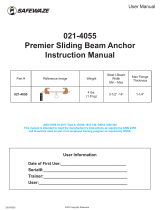 SafeWaze 021-4055 El manual del propietario
SafeWaze 021-4055 El manual del propietario
-
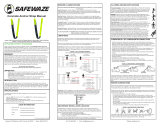 SafeWaze 70300 El manual del propietario
SafeWaze 70300 El manual del propietario
-
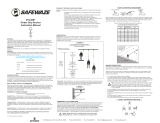 SafeWaze 019-4007 El manual del propietario
SafeWaze 019-4007 El manual del propietario
-
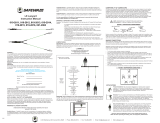 SafeWaze 019-2015 El manual del propietario
SafeWaze 019-2015 El manual del propietario
-
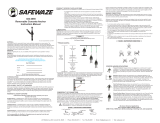 SafeWaze 022-4085 El manual del propietario
SafeWaze 022-4085 El manual del propietario
-
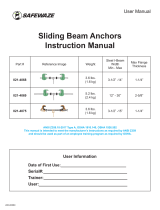 SafeWaze 021-4068 El manual del propietario
SafeWaze 021-4068 El manual del propietario
-
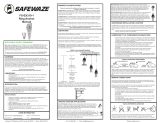 SafeWaze FS-EX310-1 El manual del propietario
SafeWaze FS-EX310-1 El manual del propietario
-
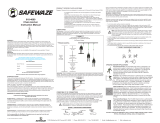 SafeWaze 018-4000 El manual del propietario
SafeWaze 018-4000 El manual del propietario
-
 SafeWaze 019-11000 El manual del propietario
SafeWaze 019-11000 El manual del propietario
-
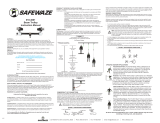 SafeWaze 018-4001 El manual del propietario
SafeWaze 018-4001 El manual del propietario
Otros documentos
-
DBI-SALA DBI-SALA® Reusable Heavy-Duty Roof Anchor 2103673, 1 EA Instrucciones de operación
-
3M PROTECTA® PRO™ Reusable Hinged Roof Anchor 2104000, 1 EA Instrucciones de operación
-
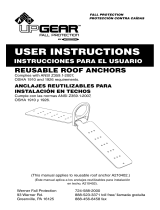 UpGear by Werner A210402 Guía de instalación
UpGear by Werner A210402 Guía de instalación
-
3M 1246011 Manual de usuario
-
3M DBI-SALA® Fixed Ladder SRL Anchor System Kit 6100569 Manual de usuario
-
3M 3101006 Manual de usuario
-
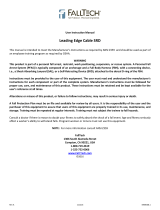 FallTech 727650LE Guía del usuario
FallTech 727650LE Guía del usuario
-
3M DBI-SALA® Sliding Beam Anchor 2104712, Small, Pallet 64 Units Instrucciones de operación















